Braibant S., Giacomelli G., Spurio M. Particles and Fundamental Interactions: An Introduction to Particle Physics
Подождите немного. Документ загружается.

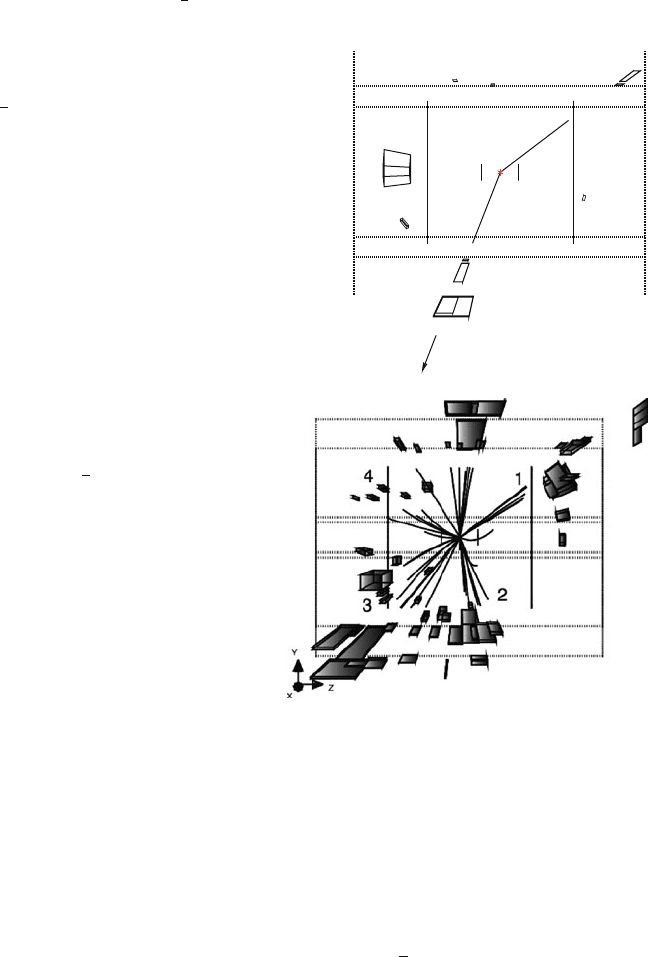
9.8 e
C
e
Collisions for
p
s > 100 GeV at LEP2 259
Fig. 9.14 Radiative event
e
C
e
! e
C
e
!
Z
0
!
C
observed at
p
s D 130 GeV with a LEP
detector. The event is shown
in a longitudinal view which
is perpendicular to that shown
in Fig. 9.6
μ
μ
γ
Fig. 9.15 Event display of
the process
e
C
e
! W
C
W
!
4 quarks ! 4 hadronic jets
observed at
p
s D 161 GeV
with a LEP detector. The W
C
and W
are produced almost
at rest; the W
C
decays in the
jets 1 and 3
.W
C
! jet 1 C jet 3/,
while the W
decays in the
jets 2 and 4
.W
! jet 2 C jet 4/
LEP2 allowed one to explore the energy region 130 < E
cm
< 209 GeV. At such
energies, it became possible to study the reactions
e
C
e
! W
C
W
(9.39a)
e
C
e
! Z
0
Z
0
: (9.39b)
The production thresholds are E
cm
D 2m
W
D 160:7 GeV and 2m
Z
D 182:4 GeV,
respectively. Figure 9.15 shows an event display of the process e
C
e
! Z
0
!
W
C
W
! 4q ! 4jetsat the threshold energy
p
s D 161 GeV. The W
C
W
are
produced almost at rest and each of them decays into two jets in opposite directions.
The cross-sections for the processes (9.39) can be calculated using the Feynman
diagrams shown in Fig. 9.16. Amongst those, the most interesting is the diagram
shown in Fig. 9.16c, which contains the triple boson vertex Z
0
W
C
W
. The dia-
gram with the Higgs boson (Fig.9.16d) is also important to eliminate divergences.
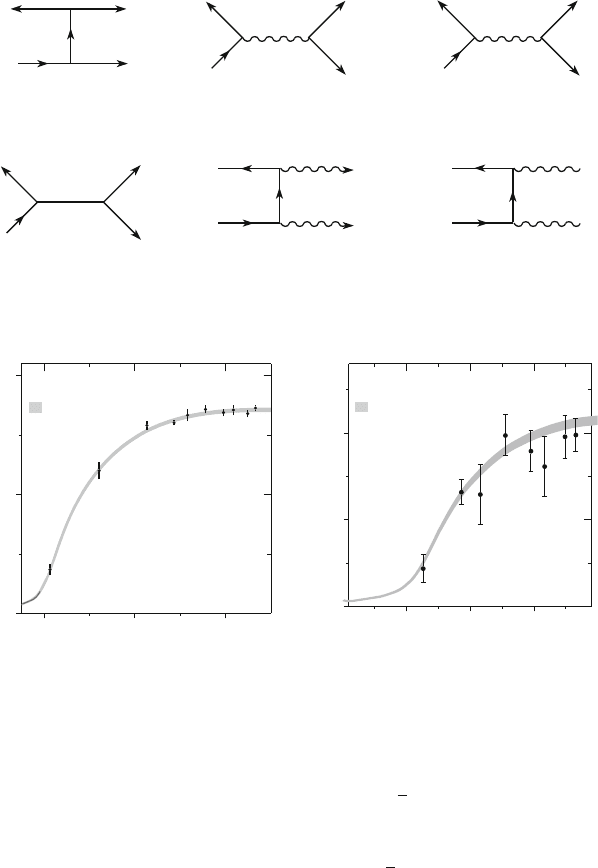
260 9 Discoveries in Electron-Positron Collisions
e
–
e
+
W
+
e
+
W
+ e
+
e
+
Z
0
e
+
W
+
e
+
W
+
Z
0
H
0
W
–
e
–
e
–
W
–
e
–
Z
0
e
–
W
–
e
–
W
–
γ
γ
γ
ν
e
++
a
bc
d
e
f
Fig. 9.16 Lowest order Feynman diagrams (a), (b), (c), and (d) for the process e
C
e
!
W
C
W
,(e)theZ
0
Z
0
production and (f) the annihilation in two photons
√s (GeV)
σ
WW
(pb)
LEP
0
10
20
160 180 200
0
0.5
1
180 190 200
√s (GeV)
σ
ZZ
(pb)
MS
LEP
MS
a
b
Fig. 9.17 Cross-section of (a) the process e
C
e
! W
C
W
and (b) of the reaction e
C
e
!
Z
0
Z
0
. The points are the combinations [9L03] of the experimental data of the four LEP
experiments, compared with a prediction of the electroweak theory (shaded area)
Figure 9.17a shows the dependence as a function of
p
s of the cross-section of the
process (9.39a): note that the cross-section starts to increase below the production
threshold because of the large width of the W
C
;W
bosons (
W
). Note also that
the cross-section increases rapidly with increasing
p
s: this is a typical behavior
for any “new” channel reaching the production threshold. The cross-section for the
reaction (9.39b) shows a similar behavior (see Fig. 9.17b).
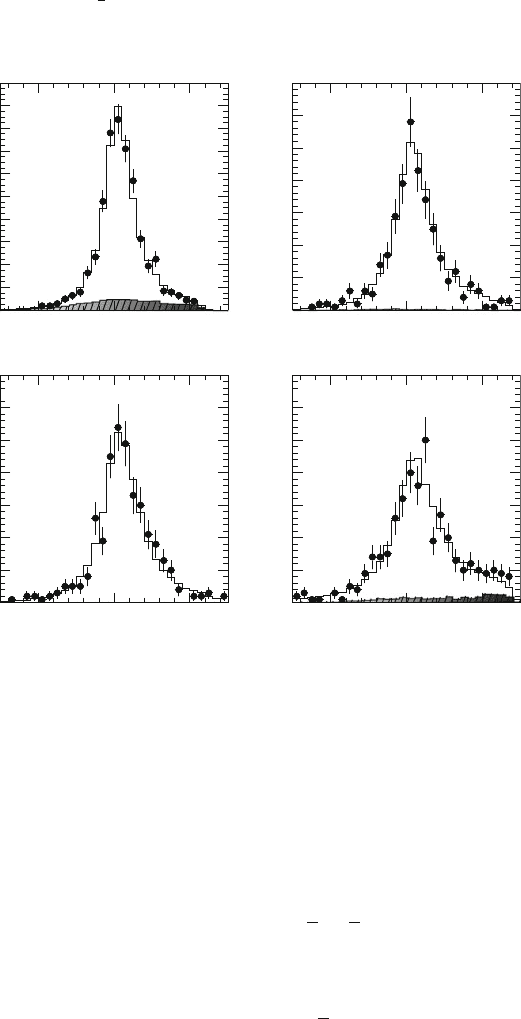
9.8 e
C
e
Collisions for
p
s > 100 GeV at LEP2 261
OPAL
√
s=189 GeV
0
20
40
60
80
100
120
140
160
180
200
70
80
90
m
rec
/ GeV
m
rec
/ GeV m
rec
/ GeV
m
rec
/ GeV
Events
Events
Events
Events
0
10
20
30
40
50
60
70
70
80 90
0
10
20
30
40
50
60
70
70 80 90
0
10
20
30
40
50
60
70
70 80 90
WW→qqqq WW→qqev
WW→qqmn WW→qqτn
Fig. 9.18 Histograms [9A01] of the invariant mass reconstructed in the hadronic channel and in
the three semileptonic channels. The dots correspond to the data. The contribution of non-WW
background is shown as shaded histograms
9.8.2 The W Boson Mass and Width
The W boson mass was measured using the following channels:
• The hadronic channel, which represents 46% of the decays:
e
C
e
! W
C
W
! qq
0
q
00
q
000
(9.40a)
• The semileptonic channel, which represents 44% of the decays:
e
C
e
! W
C
W
! q q
0
l
l
: (9.40b)
The invariant mass of the W decay products is computed event by event. Figure 9.18
shows the invariant masses reconstructed in the hadronic channel and in the three
semileptonic channels. Background events are mainly present in the hadronic

262 9 Discoveries in Electron-Positron Collisions
channel (four jets in the final state); they are mostly due to an incorrect assignment
of jets to each W (“combinatorial background”). The invariant mass spectra are then
used to reconstruct the mass of the W boson. A kinematic fit is performed, imposing
the four constraints of energy and momentum conservation; it is also required that
the masses of the two bosons be the same (fifth constraint).
The combination of the four LEP experiments gives the following results:
m
W
D 80:376 ˙ 0:033 GeV (9.41a)
W
D 2:196 ˙ 0:083 GeV: (9.41b)
9.8.3 Measurement of ˛
S
The LEP experiments have carried out many studies on the global properties of
multihadronic final states, both at the Z
0
peak and at c.m. energies
p
s>100 GeV.
In particular, the global structure of multihadronic events using “event shape”
variables were studied in detail; the relative frequency of events with a given number
of jets with respect to the total multihadronic production (“jet rate”); the hadronic
charged multiplicity. The distribution of the hadronic charged multiplicity as a
function of the c.m. energy
p
s is shown in Fig. 9.19 for e
C
e
, p.p/p and ep
colliders.
Various experimental methods based on these studies allowed the measurement
of ˛
S
and the verification of the QCD predictions (discussed in Sect. 11.9.4). For
instance, the ˛
S
“running” (i.e., the fact that ˛
S
decreases with increasing E
cm
)
is rather interesting. Combining the results [9w2] from the four LEP experiments,
one has
˛
S
.
p
s D m
Z
/ D 0:1199 ˙ 0:0052
˛
S
.
p
s D 206 GeV / D 0:1079 ˙0:0014:
9.8.4 The Higgs Boson Search at LEP
Another motivation for the study of e
C
e
collisions above the Z
0
peak was the
search for new particles and particularly for the Higgs boson (see also 10.10).
As we shall see in Chap. 11, the Higgs boson is an essential particle in
the Standard Model. At least one neutral boson, the H
0
, should exist after the
spontaneous symmetry breaking to give masses to the W
˙
and Z
0
bosons, while
keeping the theory renormalizable. The model predicts the couplings of the Higgs
boson, but not its mass. The H
0
production cross-section is expected to decrease
rapidly with increasing M
H
0
.

9.8 e
C
e
Collisions for
p
s > 100 GeV at LEP2 263
0
5
10
15
20
25
30
35
40
1 10
10
2
10
3
〈N
ch
〉
e
+
e
−
data
γγ2, MARK I
LENA
CLEO
ARGUS
HRS,
TPC
JADE, TASSO
AMY
TOPAZ, VENUS
MARK II
ALEPH, DELPHI
L3, OPAL
Bubble
Chambers
ISR
UA5
e
±
p data
H1, ZEUS
p(p) - p data
√s [GeV]
Fig. 9.19 Hadronic charged multiplicities measured by experiments at e
C
e
, p.p/p and ep
colliders as a function of
p
s [P10]. The indicated errors are statistical and systematic errors added
in quadrature
At LEP, the Higgs boson search was made mainly through the “Higgsstrahlung”
process e
C
e
! Z
! HZ (see Fig. 9.20a). The kinematic limit for this
process is given by M
max
H
'
p
s m
Z
;sincem
Z
D 91 GeV, one obtains
M
max
H
' 115116 GeV for
p
s D 206207 GeV. It is expected that a Higgs with a
mass 115 GeV would decay in b
N
b pairs in 74% of the cases since the H coupling
is proportional to the mass of the fermion to which it couples. The decays in
pairs, gluon pairs (7% each) and in c
c (4% ) are less important. The final state
topologies are determined from these decays and those of the associated Z
0
boson.
At LEP, the H
0
boson was searched in the following channels:
1. Four hadronic jet channels: e
C
e
! H
0
Z
0
! bbqq
2. Missing energy channel: e
C
e
! H
0
Z
0
! bb
3. channel: e
C
e
! H
0
Z
0
!
C
qq, ! qq
C
4. Leptonic channels: e
C
e
! H
0
Z
0
! bbe
C
e
; ! bb
C
.
Figure 9.20b,c show the final state topology (in the plane transverse to the beam
axis) in the missing energy channel and in the leptonic channel (Z
0
! e
C
e
). The
channels Z
0
! , H
0
! qq,
C
are characterized by an asymmetric topology
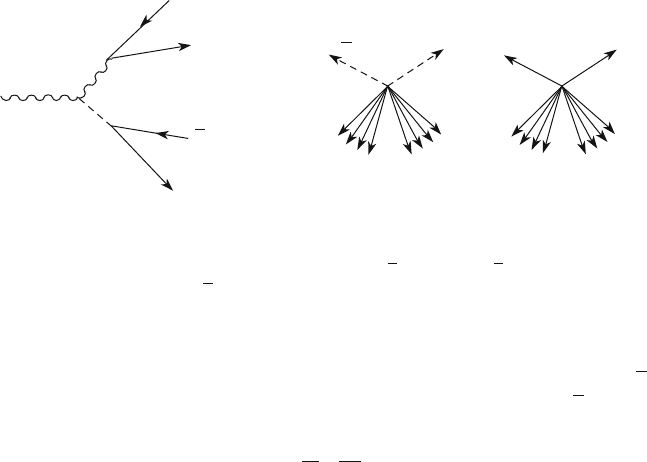
264 9 Discoveries in Electron-Positron Collisions
Z
0
H
0
e
+
e
–
ν
–
, e
+
, μ
+
Z
0
*
ν
ν
ν, e
–
, μ
–
q, τ
+
q, τ
–
Hadrons Hadrons
Hadrons Hadrons
abc
Fig. 9.20 (a) Feynman diagrams for the production and decay of a neutral Higgs boson, H
0
.(b)
Sketch of a typical event predicted in the channel Z
! and H
0
! qq.(c)Asin(b)forthe
channel Z
0
! e
C
e
, H
0
! qq
with two hadronic jets in one hemisphere and a large missing energy in the opposite
hemisphere. These are important channels because the branching ratio Z
0
!
is large (20% ). Also, the channels Z
0
! e
C
e
;
C
and H
0
! qq;
C
have a simple and characteristic signature with a high detection efficiency; however,
they have a smaller branching ratio. The background arises from Standard Model
processes e
C
e
! Z
0
Z
0
;W
C
W
;fff
0
f
0
, which are very similar to the Higgs
candidate events if the mass M
H
is close to that of the m
Z
. Such a background is
reduced by applying selection criteria exploiting the kinematic differences with the
signal (properties of the hadronic jets and of the event); these selections vary from
experiment to experiment, and from channel to channel.
Combining the results of the four LEP experiments, a lower limit on the mass of
the Standard Model Higgs boson was obtained: 114:4 GeV at the 95% confidence
level. A small excess (2:1) on top of the SM background was observed, mainly in
the data collected from ALEPH in the 4-jet channel at E
CM
> 206 GeV.

Chapter 10
High Energy Interactions and the Dynamic
Quark Model
10.1 Introduction
In the first part of this chapter, we study deep inelastic scattering (DIS) between
leptons and nucleons. DIS experiments confirmed that quarks are not fictitious
mathematical objects. DIS processes involve high transferred momentum from the
lepton to the hadron constituents (the quarks). Quantum chromodynamics (QCD),
the field theory describing the strong interaction between quarks and gluons,
predicts a small value of the coupling constant ˛
S
at large transferred momentum.
Usually, such events have a large transverse momentum (high-p
t
), which is the
momentum perpendicular to the colliding beams. These high-p
t
processes can be
computed with perturbation methods.
In the second part of the chapter, we continue with a review of hadron-hadron in-
teractions. These processes are characterized by large cross-sections, slowly varying
with the energy available in the center of mass (c.m.) system. Most collisions have
low transverse momentum (low-p
t
processes). It can be hypothesized that low- p
t
interactions involve hadrons as a whole and not only their subconstituents. Since ˛
S
is large when the transferred momentum is small, perturbation theory cannot be used
to describe low-p
t
interactions. Experimental results must therefore be interpreted
using various phenomenological models. At the end, the expected performances of
the LHC collider in the search for the Higgs boson are discussed.
10.2 Lepton–Nucleon Interactions at High Energies
Deep inelastic lepton–nucleon collisions provided important information on proton
and neutron structure. Historically, the first experimental study was the electron-
nucleus elastic scattering, which allowed one to measure the distribution of electric
charge inside nuclei (Chap. 14). They were followed, starting at the end of the 1960s
by a series of experiments on deep inelastic scattering of electrons on nucleons,
S. Braibant et al., Particles and Fundamental Interactions: An Introduction to Particle
Physics, Undergraduate Lecture Notes in Physics, DOI 10.1007/978-94-007-2464-8
10,
© Springer Science+Business Media B.V. 2012
265

266 10 High Energy Interactions and the Dynamic Quark Model
which revealed the proton (and neutron) quark structure. Muon beams of ever
increasing energy and quality and finally, high luminosity neutrino beams were
used. The improved technology of producing
beams and the development of
large detectors led to the detailed studies of neutrino-nucleon interactions. It should
be remembered that it is easier to produce proton or electron beams than beams of
muons or neutrinos which are decay products of secondary particles. In inelastic
ep (p ) collisions, there are two structure functions related to the magnetic and
electric interactions, and corresponding to the two helicity states of the exchanged
photon. The inelastic
C N !
C X process depends on three nucleon
structure functions related to the three helicity states of the W
˙
bosons. Finally,
in the mid-1990s, the HERA collider at Hamburg, Germany, became operational.
This accelerator allowed one to study the ep processes in a very large interval of
kinematic variables. In each case, the studied reactions were
` C N ! `
0
C X; (10.1)
where ` and `
0
are charged or neutral leptons; N is the proton or neutron; the
hadronic system X can be observed, unobserved or only partially observed.
The most important result was the discovery that inelastic `N collisions can
be interpreted as the impact of the incident lepton with one constituent of the
nucleon, a parton, a point-like fermion later identified as a quark or an antiquark.
In the original parton model of the proton, the parton constituents were seen
as noninteracting point-like particles. Lately, it became evident that partons are
confined inside protons and must interact with each other. The parton model is
a “naive” representation of the proton structure. The deep inelastic `N collision
has a simple interpretation in a reference system (the infinite momentum frame)in
which the proton has high momentum, each parton carries a fraction x of the proton
momentum, and masses and transverse momenta of partons can be neglected.
The most studied deep inelastic reactions are
ep W e
˙
C p ! e
˙
C X
C
(10.2a)
p W
˙
C p !
˙
C X
C
(10.2b)
p.CC / W
C p !
C X
CC
;
C p !
C
C X
0
(10.2c)
p.NC / W
C p !
C X
C
;
C p !
C X
C
: (10.2d)
The X symbol represents a generic final state whose total electric charge is relevant.
The first two reactions proceed through the exchange of a photon (the exchange
of a Z
0
boson only gives an important contribution at high energies). The last two
are weak interaction processes: the third reaction proceeds through the exchange of
a W
˙
boson (charged current, CC); the last requires the exchange of the neutral
massive Z
0
boson (neutral current, NC). The four reactions are shown in Fig. 10.1a
at the level of elementary particles and in Fig. 10.1b in terms of the static quark
model of hadrons, where only the so-called “valence quarks” are considered as
partons.
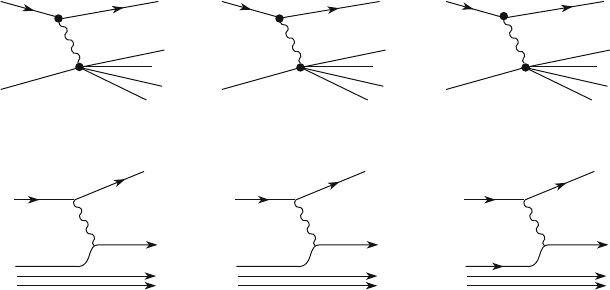
10.2 Lepton–Nucleon Interactions at High Energies 267
e,μ
e,μ
e,μ
e,μ
ν
μ
ν
μ
ν
μ
ν
μ
ν
μ
ν
μ
μ
−
μ
−
W
+
W
+
Z
0
Z
0
γ
γ
N
a
b
NN N
N
N
u/d
u/d
u/d
u/d
d
u
hadrons
(i) EM interaction (ii) CC weak interaction (iii) NC weak interaction
÷α
ΕΜ
÷α
ΕΜ
Fig. 10.1 Inelastic lepton–nucleon scattering at the level of (a) elementary particles and (b)in
the simplest quark model. The two noninteracting quarks are “spectators” which hadronize (i.e.,
produce a large number of low p
t
hadrons) in a forward jet. The evolution of the static quark
model will take into account the sea quarks and antiquarks, and the gluons present within the
nucleon
Submicroscopic structures can be studied with real or virtual photons: the
dimension scale that can be tested is inversely proportional to the transferred
momentum. The internal structure of the nucleon can be studied with high en-
ergy inelastic collisions of charged leptons which occur via the exchange of a
virtual photon, as shown in Fig.10.1a. Deep inelastic collisions are characterized
by a high transferred momentum squared, Q
2
.AsQ
2
increases, smaller and
smaller distances can be explored, according to the uncertainty relation xpc '
xQc '„c 197 MeV fm; for Q
2
D400 GeV
2
=c
2
, one has x '10
17
m;
for Q
2
D40;000 GeV
2
=c
2
(the maximum reached at the HERA collider), one has
x 10
18
m.
Figures 10.1band10.2 illustrate some inelastic collision processes in the simplest
quark model. The incident lepton interacts with a (valence) quark of the nucleon
by emitting a high-Q
2
boson. Other constituents, such as gluons, “sea” quarks and
antiquarks, are neglected. Figure 10.2 shows a two-stage process: the first stage is an
almost elastic collision of the lepton with a quark, which carries a fraction x of the
proton momentum; the virtual boson is absorbed by the quark. The corresponding
structure function F.x/ describes the momentum distribution of the constituents
within the proton. The photon (and also the massive W
C
;W
;Z
0
bosons) does
not interact directly with gluons, which are continuously exchanged to confine the
quarks inside the proton.
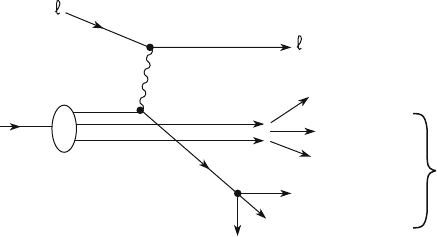
268 10 High Energy Interactions and the Dynamic Quark Model
'
γ, z
0
xP
q'
F(x, Q
2
)
D(z,Q
2
)
Target
jet
Current
jet
Hadrons
p
zp'
p'
P
Fig. 10.2 Sketch of an inelastic lepton–nucleon scattering as a two-stage process. The parton
interacting with the lepton carries a fraction x of the proton four-momentum P . The first stage
involves the structure function F.x;Q
2
/. In the second stage, the scattered parton, with four-
momentum Q, gives rise to a jet of hadrons (current jet). The fragmentation function D.z;Q
2
/
is defined for each hadron carrying a fraction z of the jet energy. The remaining two quarks are
“spectators” and hadronize in a forward jet (target jet)
The second stage of the process is the parton fragmentation into two jets
of hadrons. This is a complicated multistage strong interaction process, which
“dresses” naked quarks to form hadrons in the final state. The first hadron jet comes
from the parton interacting with the lepton and the second (denoted as spectator jet
or target jet) comes from the spectator partons. Usually, the first jet is at large angles
(high-p
t
) and the second is emitted almost in the same direction of the incident
proton (low-p
t
). The energy distribution of each hadron type from the interacting
parton is called the fragmentation function, D.z;Q
2
/. It gives the probability that
a given hadron carries a fraction z of the interacting parton energy. This energy
is not experimentally measurable and must be estimated. In this second stage, the
gluons play an important role. As illustrated in this chapter, the strong interaction
amongst constituents modifies the structure function, making it dependent on
Q
2
, F.x;Q
2
/.
The
virtual
-parton collision of the first phase occurs within a time t
1
„=,
where D E E
0
is the transferred energy. The quark hadronization (or quark
dressing) is characterized by a time t
2
„=m
p
c
2
' 10
24
s (m
p
D proton mass).
If m
p
, one has t
1
t
2
and the two subprocesses can be considered as
distinct. In general, the hadronization occurs within
t
hadroniz
„=Mc
2
' 10
23
10
24
s; (10.3)
where M is the mass of the formed hadron system. Note that the production of a
top quark (t), whose mass is around 170 GeV, represents a special case. Due to its
very high mass, the decay time through weak interaction (see Fig. 8.20) is smaller
than the hadronization time. Unlike the other quarks, the t quark has no time to get
dressed before decaying.
